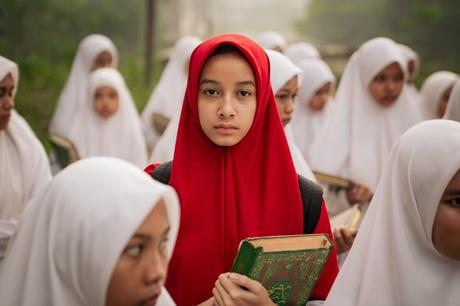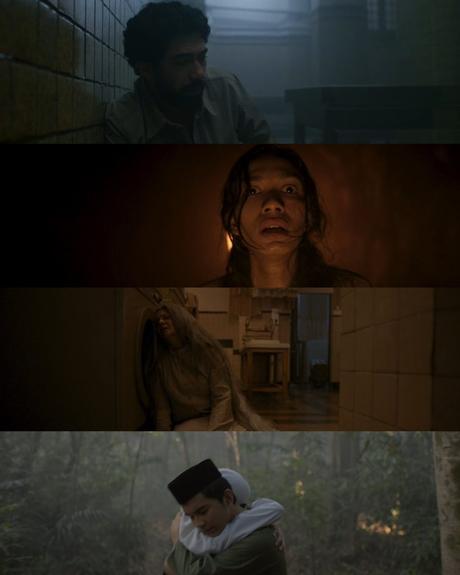
In Grave Torture (2012), Joko Anwar ushers audiences into the realm beyond the living through minimum dialogues and a narrative tidbit that, albeit modest, baffling.
The short follows the story of a grief-stricken boy who, upon his criminal father’s passing, decides to stay in the deceased’s casket and involuntarily witness the titular torture. Compared to the director’s body of work up to that period, the short is by any means low-key – in scales and presentation; however, it also harbors a seed of a bigger idea (re: over-sophisticated lore that the director would be synonymous within the present time).
The short’s final sequence envelops the sentiment perfectly. After the gruesome allusion to the grave torment, the boy is retrieved back to the world of the living, but there’s a twist — he’s coming back as an old man (more accurately, a boy with an old man’s face). Odd as it is, but for those familiar with Islamic eschatology, it might tingle their senses. It’s what Anwar does best: sending pulses into the audience’s imagination.
Fast forward to 2024, Anwar returns with his tenth feature, Siksa Kubur (Grave Torture) — an expansion of that baffling seed. This feature film is of a different breed; it’s star-studded, dialogue-heavy, and clocking in at almost 2 hours. Yet, it’s a piece of the same cloth. Everything in the modest short finds respective manifestations in this ambitious foray. Yet, has ambition made it even more profound than modesty?
 Widuri Puteri portraying Sita with a ‘Scarlett Letter’ reference
Widuri Puteri portraying Sita with a ‘Scarlett Letter’ reference
A Grave Matter
You don’t need to see to believe. That’s what Sita (Faradina Mufti), the protagonist, is told in an out-of-place séance in the middle of Siksa Kubur. At that very moment, what I could think of was a verse from the Book of John confronting the doubting Thomas: blessed are those who have not seen, and yet have believed. It’s from a different belief, but I found the common ground. I’m convinced that this film is talking about Faith. The red-smeared faith with a bold, capitalized F.
What Sita has been trying to believe (or rather debunk) is the existence of grave torture – the divine punishment given to the evils after death. For her, proving that such a concept is non-existent feels like retribution. And, that deed has become her ultimate life goal (it’s pretty ironic because what she seeks does not belong to the mortal realm).
As a teenager, Sita (portrayed excellently by Widuri Puteri – stellar casting decision) and her brother, Adil (Muzakki Ramdhan) witnessed their parents killed in a suicide bombing perpetrated by a man who claimed to have listened to a recording of real hellish torment beyond the grave. Orphaned and penniless, the siblings then get sent to a religious dormitory school where another nightmare awaits them. This is where Anwar retraces the veins from his 2012 short to find a way to the feature iteration. Both stories glance into the underworld from the perspective of grief-stricken children. In the short film, the grief grows into an attachment that finally probes curiosity; meanwhile, Siksa Kubur does the opposite. Grief grows into detachment and, eventually, an unquenchable thirst for revenge.
The next moment we see Sita, she’s grown to be a gritty, sharp-eyed woman working as a caretaker in a nursing home. She’s devised a plan with her brother – now a mortician (portrayed by Reza Rahadian exuding Rahul Kohli’s vibe) – to find a completely wretched man to follow to the grave. Working closely with the old and the dead has only made their plan (or, at least, the plot) easier to carry out. This is the face of revenge that Sita craves for — dirt-soaked, six-foot-under silence of a grave. If she can prove that the titular concept is nothing but a pure nonsense, she can find peace.
In setting up this provocative story, Anwar showcases his pointed acumen. He puts his judgment, his characters, and his audiences on a plain field. From the shocking opening, we know this is gonna be a ride; but, this isn’t a by-the-book ride. It’s not a challenge to a particular belief; it’s, instead, opting to be a series of questions with supposedly open-ended answers. At least, it seems he’s aware not to present this as a fantasy horror exploiting mostly graphic imagery of the punishing purgatory for the sake of it.
For the filmmaker, however, this proves to be a challenge to his MO. Being a writer and director, he’s used to being aware of the details on the screen and pretexts that might or might not happen off-screen. This makes most of his stories aggravatingly visual (or at least resorting to visual representations more often than not). He’s a precise filmmaker with a penchant for planting shreds of evidence and spreading breadcrumbs only to pick them back up at specific times. Having an open-ended hypothesis defies his convention; yet, he’s up for the tasks to some point.

Has “Where Do We Go When We Die?” Always Been An Open-Ended Question?
To call it a religious horror might be an understatement, even when the film arrives at the peak of this subgenre’s wave. This time, Anwar returns to his psychological thriller era although he still has a few horror tricks up on his sleeves. There are moments where Siksa Kubur’s narrative feels like leaping face down to some kind of tripping substance. Moments (if they can be referred to as such) suddenly lose a corporeal meaning as characters’ actions and fate begin to fall into question.
Moments become incoherently moving in asynchronous ways – making some sequences feel bizarre and out of place (re: the séance sequence I discussed before). In the end, some of these scenes will finally make sense; but, from my reading, this series of events simply fills the conceptual void with visual representations for the sake of making the concept viable. In simpler words, they have just got to be there, otherwise, the narrative won’t work. When that happens, a fleeting thought crossed my mind. These things make a great concept, yet, visual cues cannot always capture the essence in its entirety.
With that sense in mind, I perceive how Siksa Kubur unravels is unlike an explosive thriller that the filmmaker has been known for all along (although it will get to there, too, in a point-of-no-return intersection). The descent is like a slow-burning dynamite. To get there, the narrative takes time to infuse the idea and disbelief into the trajectory. In an intriguing way to unravel it, a detached observer working in a completely different direction with such a flow is needed. That’s how Sita is molded into a hardened woman, who seemingly takes rash decisions in most steps, but never slips to provide her with motivations and signs that the answer lies somewhere on the horizon. Mufti’s performance is reflective of what the director envisions, making audiences curious enough about what awaits her in the end.
Her psyche pilgrimage reminds me of Adrian Lyne’s Jacob’s Ladder in more ways than one. Even, there’s an on-screen dialog that resembles Eckhart’s quote in that film: “The only thing that burns in hell is the part of you that won’t let go of life.” That quote resonates with the remark that Anwar’s baddie, Wahyu (Slamet Rahardjo) mentions about the afterlife torment being reflective of what we fear most in life. For most people, it might be phobias or the sins they can’t let go of when they die. For Sita, it’s the fear that the so-called grave torture is real.
To “prep up” audiences for the unforeseeable finale, Anwar often resorts to his easter-eggs bonanza that sends most devoted fans down yet another rabbit hole. This time, however, I feel that he listened to the criticism of his vehement catch-all exposition (that becomes instant resolution in his thrillers like Modus Anomali and Impetigore); he opts not to go into full-explanation mode. He takes the gist of leaving some ambiguity on. But, that doesn’t mean that he has cracked the code just yet.
As demonstrated in Pengbadi Setan (Satan’s Slave), Anwar is a meticulous filmmaker with a flair for details – that goes beyond the film (if he could make a companion encyclopedia to his each of his films, he would). Details are executed with scalpel precision according to his vision; and, boy, his vision is often super indulging. Siksa Kubur sees how the director’s vision soaring high with an open-ended question in the finish line. Yet, oftentimes, his precise filmmaking inadvertently blurs what’s left of the ambiguity. Seemingly, the filmmaker’s stance in no-random-things-went-unchecked policy caught up with the thematic obscurity he aims for (or maybe it’s never intended that way? If so, then, I read this wrong the whole time).
The mind-boggling third act is a perfect specimen for such an argument. After a slow build-up, all hell breaks loose as events shift here and there around Sita’s life. We can feel a sense of chaos there; however, it’s all too calculated. It unravels like a predicted havoc that nullifies the ambiguity that’s always been hinted. Even when not resorting to an unnerving yet garden-variety plot twist this time (instead, he opts for something that seemingly is open for interpretation), all clues presents – scattered around too precisely not to notice – leading up to nothing but a guided interpretation. Siksa Kubur doesn’t end in a twist, but it feels it does. In the end, the answer is not an open-ended interpretation, but a downright inconclusiveness.
Verdict: Well-crafted Siksa Kubur challenges religious perspective through its own Jacob’s Ladder game. Provocative & ambitious in all fronts — yet too precise & inclined at times, blurring the sense of ambiguity that should’ve made the whole pilgrimage worth the ride.
